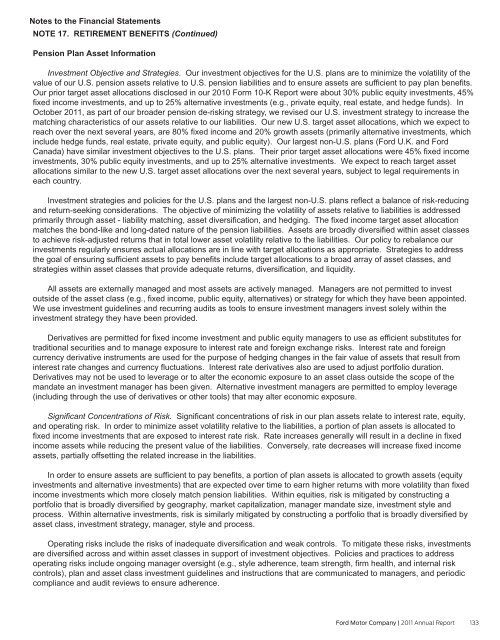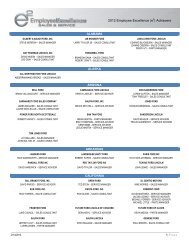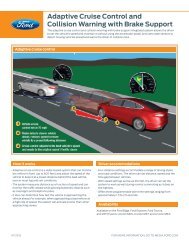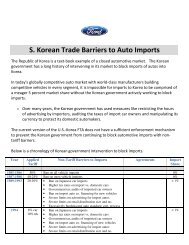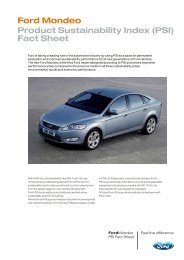Annual Report 2011 - Ford Motor Company
Annual Report 2011 - Ford Motor Company
Annual Report 2011 - Ford Motor Company
You also want an ePaper? Increase the reach of your titles
YUMPU automatically turns print PDFs into web optimized ePapers that Google loves.
Notes to the Financial Statements<br />
NOTE 17. RETIREMENT BENEFITS (Continued)<br />
Pension Plan Asset Information<br />
Investment Objective and Strategies. Our investment objectives for the U.S. plans are to minimize the volatility of the<br />
value of our U.S. pension assets relative to U.S. pension liabilities and to ensure assets are sufficient to pay plan benefits.<br />
Our prior target asset allocations disclosed in our 2010 Form 10-K <strong>Report</strong> were about 30% public equity investments, 45%<br />
fixed income investments, and up to 25% alternative investments (e.g., private equity, real estate, and hedge funds). In<br />
October <strong>2011</strong>, as part of our broader pension de-risking strategy, we revised our U.S. investment strategy to increase the<br />
matching characteristics of our assets relative to our liabilities. Our new U.S. target asset allocations, which we expect to<br />
reach over the next several years, are 80% fixed income and 20% growth assets (primarily alternative investments, which<br />
include hedge funds, real estate, private equity, and public equity). Our largest non-U.S. plans (<strong>Ford</strong> U.K. and <strong>Ford</strong><br />
Canada) have similar investment objectives to the U.S. plans. Their prior target asset allocations were 45% fixed income<br />
investments, 30% public equity investments, and up to 25% alternative investments. We expect to reach target asset<br />
allocations similar to the new U.S. target asset allocations over the next several years, subject to legal requirements in<br />
each country.<br />
Investment strategies and policies for the U.S. plans and the largest non-U.S. plans reflect a balance of risk-reducing<br />
and return-seeking considerations. The objective of minimizing the volatility of assets relative to liabilities is addressed<br />
primarily through asset - liability matching, asset diversification, and hedging. The fixed income target asset allocation<br />
matches the bond-like and long-dated nature of the pension liabilities. Assets are broadly diversified within asset classes<br />
to achieve risk-adjusted returns that in total lower asset volatility relative to the liabilities. Our policy to rebalance our<br />
investments regularly ensures actual allocations are in line with target allocations as appropriate. Strategies to address<br />
the goal of ensuring sufficient assets to pay benefits include target allocations to a broad array of asset classes, and<br />
strategies within asset classes that provide adequate returns, diversification, and liquidity.<br />
All assets are externally managed and most assets are actively managed. Managers are not permitted to invest<br />
outside of the asset class (e.g., fixed income, public equity, alternatives) or strategy for which they have been appointed.<br />
We use investment guidelines and recurring audits as tools to ensure investment managers invest solely within the<br />
investment strategy they have been provided.<br />
Derivatives are permitted for fixed income investment and public equity managers to use as efficient substitutes for<br />
traditional securities and to manage exposure to interest rate and foreign exchange risks. Interest rate and foreign<br />
currency derivative instruments are used for the purpose of hedging changes in the fair value of assets that result from<br />
interest rate changes and currency fluctuations. Interest rate derivatives also are used to adjust portfolio duration.<br />
Derivatives may not be used to leverage or to alter the economic exposure to an asset class outside the scope of the<br />
mandate an investment manager has been given. Alternative investment managers are permitted to employ leverage<br />
(including through the use of derivatives or other tools) that may alter economic exposure.<br />
Significant Concentrations of Risk. Significant concentrations of risk in our plan assets relate to interest rate, equity,<br />
and operating risk. In order to minimize asset volatility relative to the liabilities, a portion of plan assets is allocated to<br />
fixed income investments that are exposed to interest rate risk. Rate increases generally will result in a decline in fixed<br />
income assets while reducing the present value of the liabilities. Conversely, rate decreases will increase fixed income<br />
assets, partially offsetting the related increase in the liabilities.<br />
In order to ensure assets are sufficient to pay benefits, a portion of plan assets is allocated to growth assets (equity<br />
investments and alternative investments) that are expected over time to earn higher returns with more volatility than fixed<br />
income investments which more closely match pension liabilities. Within equities, risk is mitigated by constructing a<br />
portfolio that is broadly diversified by geography, market capitalization, manager mandate size, investment style and<br />
process. Within alternative investments, risk is similarly mitigated by constructing a portfolio that is broadly diversified by<br />
asset class, investment strategy, manager, style and process.<br />
Operating risks include the risks of inadequate diversification and weak controls. To mitigate these risks, investments<br />
are diversified across and within asset classes in support of investment objectives. Policies and practices to address<br />
operating risks include ongoing manager oversight (e.g., style adherence, team strength, firm health, and internal risk<br />
controls), plan and asset class investment guidelines and instructions that are communicated to managers, and periodic<br />
compliance and audit reviews to ensure adherence.<br />
<strong>Ford</strong> <strong>Motor</strong> <strong>Company</strong> | <strong>2011</strong> <strong>Annual</strong> <strong>Report</strong> 133


